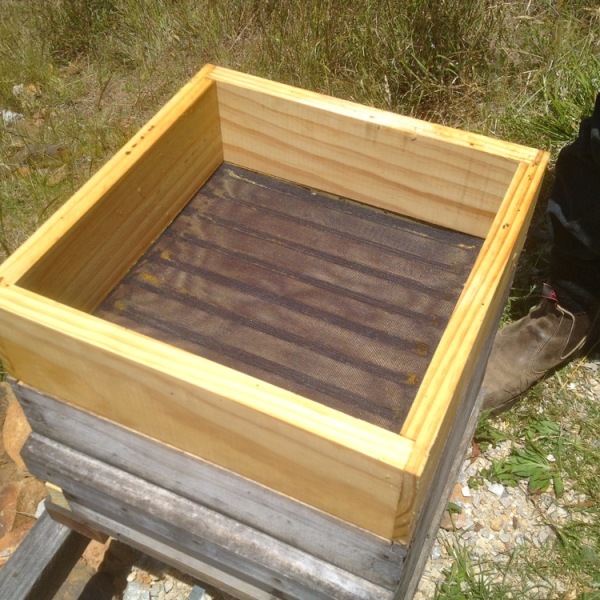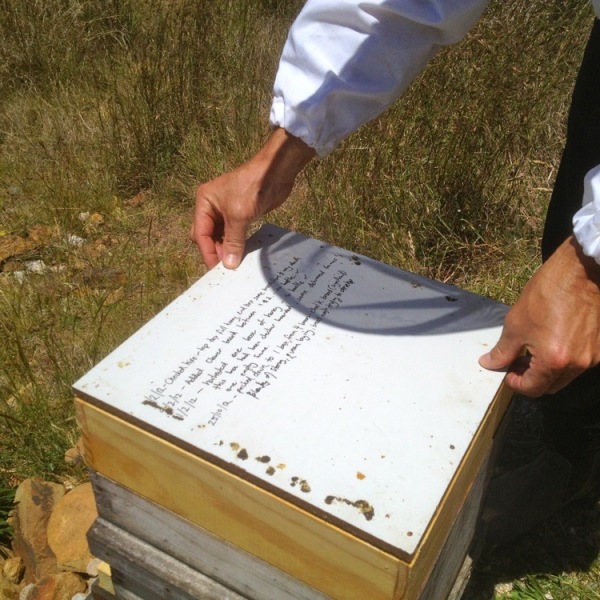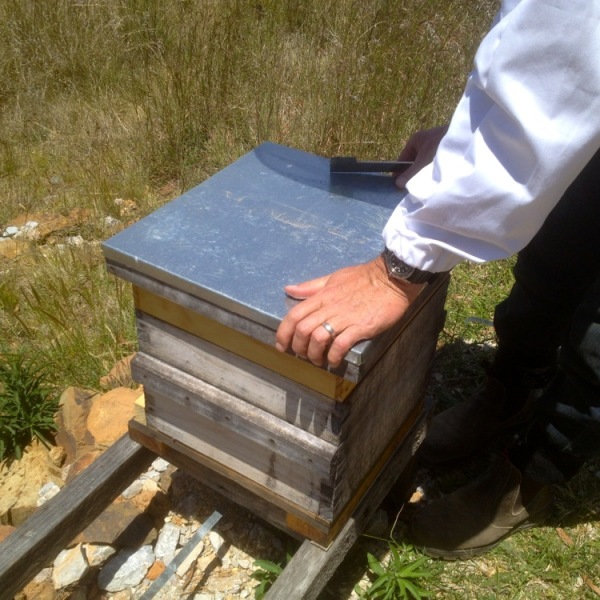In the spirit of using small and slow solutions (with large effects on gross colony happiness), Tim Malfroy has recently modified his design for quilt boxes on his Warré hives, and I’m liking his latest update.
The quilt box on a Warré hive is a simple aspect that makes a big difference to the hive’s health, in that it insulates the colony below from the radiant heat of the sun, and also contains the heat of the colony on a cold day. Tim’s latest modification makes for optimal hive health in a range of ways…
In a classic Warré hive, above the boxes, there is firstly a top bar cloth – a layer of hessian between the top box and the quilt box to prevent the quilt box being glued to the top box by the bees as they secure the boundaries of their home.
Above that there’s a quilt box with a cloth liner that is filled with wood shavings, straw or similar clean, natural and inert insulating material. As said, this provides insulation for the colony from extremes of temperature.
Here’s what Tim had to say about his re-design of these two hive parts:
The design of the quilt/cover cloth really depends on which type of roof is being, and most importantly, whether the roof covers the join between the top box and the quilt box.
If using a shallow telescoping roof that doesn’t cover the join (as currently used on the Warré hives at Milkwood), it is important that the cover cloth is cut to the internal dimensions of the box so that moisture cannot wick into the hive through the cover cloth.
Also, due to the fact I was using shallow roofs, my original design featured a calico insert for the quilt box (not a feature of the traditional design), which held the dry straw quilt filling, and eliminated any chance of moisture wicking into the top box and quilt.
Not only were these fiddly to make, but they weren’t entirely suitable for the job, often sticking to the top cloth and becoming frayed over time. So, once I found cheap natural calico sacks in which to put the wood shavings, it saved me a huge amount of time when making the hives and also out in the apiary when checking the bees.
If using a deep telescoping roof or the traditional gabled roof, then the cover cloth can be cut to the external dimensions of the hive, possibly allowing any moisture to wick from the inside to the outside.
On the underside of the quilt box a simple cloth can be used, and some beekeepers suggest that bringing the hessian/burlap out at the sides of the quilt box performs an important ventilation function as the hessian weave provides a capillary wick from any area of the cloth to each of the hive’s four exterior perimeters.
However, I think the calico sacks work great on all versions of the hive. I just change whether I cut the cover cloth to internal dimension (shallow roof) or external dimension (deep or gabled roof)
The main point here is to check the quilt contents when you open the hive, and make sure they’re dry. If they’re not, then there’s either a design/functional flaw, or perhaps your hive is sick.
I think Tim’s solution to this problem is great. Avast with the pinned quilt box liner, and enter the calico bag full of wood shavings.
It’s quick, it’s contained, it’s easy to get out and give a good check, it’s easy to swap and it secures the wood shavings so they don’t potentially blow away or go everywhere in the middle of the hive check.
We’ve also moved on from the hessian top bar cloth, towards 1mm fibreglass mesh, due to most hessian being treated with toxic nasties to prevent it being eaten my rodents etc.
Tim’s notes on this:
“Regarding the cover cloth: Although Warré recommended using hessian when he wrote Beekeeping For All decades ago, I don’t use it anymore. According to those in the know, hessian is often treated these days with chemicals to prevent rodents eating it.
So, I looked long and hard for an alternative. These days I use either natural calico, biodynamic cotton cloth, or fibreglass mesh. If using mesh, buy the 1mm ‘miniweave’ type – the small gaps mean that the bees propolise the cloth (a very good thing!), but it still can be peeled back easily.
Flyscreen mesh is obviously not the most natural choice, but it has its advantages (durable, easy to cut to size, and bees can be viewed through the mesh). Main thing is that it’s vapor permeable and bee-friendly.”

Hessian top bar cloth. Lovely, but with some drawbacks in terms of toxicity
And so there we go. A small modification that makes for happier, less stressed, more resilient bees, and in turn a happier beeekeeper too.
>> More posts about Warré beekeeping
Oh and upcoming Natural Beekeeping courses with Tim Malfroy are here…




















Nice time saving modification.
I like it.
Funny thing, I didnt have any spare hession at the time of putting one of my hives together so opted for fibreglass/plastic type fly mesh and find it much easier to handle, so I’m gonna keep using them.
Seeing this , now I’m gonna use the bag idea too.
🙂
I’ve started buying old cotton pillowslips from op shops to use as quilt bags – they fit well…
With a hive that is identical (also from Tim) to yours, and having an effectively endless supply of hessian bags, my quilt has been one of them filled with an offcut of roofing insulation. It started with the quilt box as in your 4th image filled with sawdust, but it was heavy, pulled the mesh off a bit and spilled tiny fibre around over the hive. My hessian bags are sandbags and never meant for grain or other food I am guessing. I also cut them up for use in the smoker. This talk of rodenticide or rodent deterrent… any… Read more »
Would highly recommend using pine needles or clean straw in your smoker over hessian, just in case!
I am wondering if it would be ok to use untreated wool in the quilt bag – it should have great insulation and weater wicking properties. what do you think? has anyone an opinion or experience with this?
As long as the wool was clean, could be good?